Développement de modèles pour l'évaluation des performances ...
Développement de modèles pour l'évaluation des performances ...
Développement de modèles pour l'évaluation des performances ...
Create successful ePaper yourself
Turn your PDF publications into a flip-book with our unique Google optimized e-Paper software.
TITRE: <strong>Développement</strong> <strong>de</strong> <strong>modèles</strong> <strong>pour</strong> l’évaluation <strong>de</strong>s <strong>performances</strong> circuit <strong>de</strong>s<br />
technologies CMOS avancées sub-20nm.<br />
tel-00820068, version 1 - 3 May 2013<br />
RESUME<br />
Depuis la commercialisation du premier circuit intégré en 1971, l’industrie <strong>de</strong> la microélectronique s’est fixée<br />
comme leitmotiv <strong>de</strong> réduire les dimensions <strong>de</strong>s transistors MOSFETs, en suivant la loi <strong>de</strong> Moore. Comme indiqué<br />
par Dennard, cette miniaturisation améliore automatiquement les <strong>performances</strong> <strong>de</strong>s transistors.<br />
A partir <strong>de</strong>s nœuds 28-22nm, les effets canaux courts sont trop difficiles à contrôler et <strong>de</strong> nouvelles architectures<br />
<strong>de</strong> transistors sont introduites: FDSOI <strong>pour</strong> STMicroelectronics, Trigate <strong>pour</strong> Intel.<br />
Dans ce contexte, l’évaluation <strong>de</strong>s <strong>performances</strong> <strong>de</strong>s technologies CMOS est clé et les travaux <strong>de</strong> cette thèse<br />
proposent <strong>de</strong> les évaluer au niveau circuit. Des <strong>modèles</strong> spécifiques d’estimation <strong>de</strong>s paramètres électrostatiques<br />
et <strong>de</strong>s capacités parasites sont développés. Ceux-ci sont d’abord utilisés sur <strong>de</strong>s technologies amonts (cointégration<br />
III-V/Ge et intégration 3D) puis sont implémentés en VerilogA <strong>pour</strong> être utilisés avec les outils<br />
conventionnel <strong>de</strong> CAO. Ceci fournit un modèle compact prédictif et utilisable <strong>pour</strong> toutes les architectures CMOS,<br />
qui est utilisé <strong>pour</strong> évaluer les <strong>performances</strong> logiques et SRAM <strong>de</strong>s architectures BULK, FDSOI et Trigate aux<br />
nœuds 20nm et 16nm.<br />
Mots clés :<br />
CMOS, architecture, évaluation <strong>de</strong> performance, modélisation analytique, FDSOI, FinFET, Trigate, double grille,<br />
capacité parasite, électrostatique.<br />
TITLE: Mo<strong>de</strong>ls <strong>de</strong>veloppement for power performance assessment of advanced CMOS<br />
technologies (sub-20nm).<br />
ABSTRACT<br />
Since the commercialization of the first integrated circuit in 1971, the microelectronic industry has fixed as an<br />
objective to reduce MOSFET transistor dimensions, following Moore’s law. As indicated by Dennard, this<br />
miniaturization automatically improves <strong>de</strong>vice <strong>performances</strong>.<br />
Starting from the 28-22nm technological no<strong>de</strong>, short channel effects are to strong and industrial companies<br />
choose to introduce new <strong>de</strong>vice structure: FDSOI for STMicroelectronics and Trigate for Intel.<br />
In such a context, CMOS technology performance evaluation is key and this thesis proposes to evaluate them at<br />
circuit level. Specific mo<strong>de</strong>ls for electrostatic parameters and parasitic capacitances for each <strong>de</strong>vice structure are<br />
<strong>de</strong>veloped for each <strong>de</strong>vice structure. Those mo<strong>de</strong>ls have first been used to evaluate <strong>performances</strong> of advanced<br />
technologies, such as III-V/Ge co-integration and 3D monolithic integration and have then been implemented in<br />
VerilogA to ensure compatibility with conventional CAD tools such as ELDO. This provi<strong>de</strong>s a compact mo<strong>de</strong>l,<br />
predictive and usable for each <strong>de</strong>vice structure, which has been used to evaluated logic and SRAM <strong>performances</strong><br />
of BULK, FDSOI and Trigate <strong>de</strong>vices for the 20nm and 16nm technology no<strong>de</strong>.<br />
Key words :<br />
CMOS, structure, performance assessment, analytical mo<strong>de</strong>ling, FDSOI, FinFET, Trigate, double gate, parasitic<br />
capacitance, électrostatic.

















